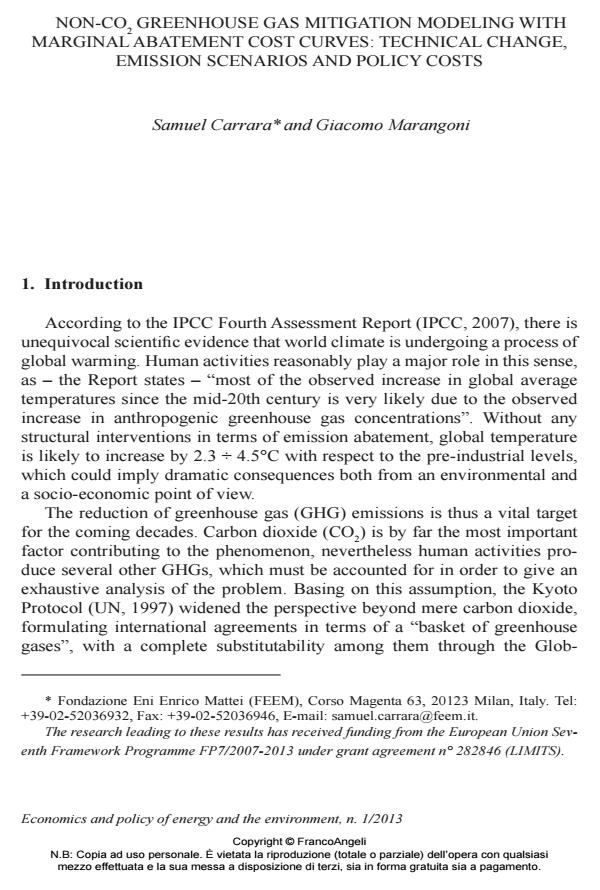Non-CO2 greenhouse gas mitigation modeling with marginal abatement cost curv es: technical change, emission scenarios and policy costs
Titolo Rivista ECONOMICS AND POLICY OF ENERGY AND THE ENVIRONMENT
Autori/Curatori Samuel Carrara, Giacomo Marangoni
Anno di pubblicazione 2013 Fascicolo 2013/1 Lingua Inglese
Numero pagine 34 P. 91-124 Dimensione file 871 KB
DOI 10.3280/EFE2013-001006
Il DOI è il codice a barre della proprietà intellettuale: per saperne di più
clicca qui
Qui sotto puoi vedere in anteprima la prima pagina di questo articolo.
Se questo articolo ti interessa, lo puoi acquistare (e scaricare in formato pdf) seguendo le facili indicazioni per acquistare il download credit. Acquista Download Credits per scaricare questo Articolo in formato PDF

FrancoAngeli è membro della Publishers International Linking Association, Inc (PILA)associazione indipendente e non profit per facilitare (attraverso i servizi tecnologici implementati da CrossRef.org) l’accesso degli studiosi ai contenuti digitali nelle pubblicazioni professionali e scientifiche
The abatement of non-CO2 greenhouse gases (OGHG) has proved to be of par- amount importance for reaching global mitigation targets. The modeling of their abatement is normally carried out referring to marginal abatement cost (MAC) curves, which by now represent a standard approach for such an analysis. As no evolution scenarios are available to describe future mitigation opportunities for OGHGs, exogenous technical progress factors (TP) are normally imposed, producing progressive MAC dilatation over time. The main aim of this work is to perform a sensitivity analysis evaluating climate and economic effects of imposing various TPs under different policy scenarios. The analysis shows that TP variation has a considerable impact on the climatic and economic results.
Keywords:Environmental economics, non-CO2 greenhouse gases, marginal abatement cost curve, technical change
Jel codes:Q54, Q55
- Baker E., Clarke L., Shittu E. (2008), Technical Change and the marginal cost of abatement. Energy Economics, 30, 6: 2799-2816. DOI: 10.1016/j.eneco.2008.01.004
- Baker E., Adu-Bonnah K. (2008). Investment in risky R&D programs in the face of climate uncertainty. Energy Economics, 30, 2: 465-486. DOI: 10.1016/j.eneco.2006.10.003
- Bernard A., Vielle M., Viguier L. (2006). Burden Sharing Within a Multi-Gas Strategy. The Energy Journal, Multi-Greenhouse Gas Mitigation and Climate Policy Special Issue, 289-304.
- Bosetti V., Carraro C., Galeotti M., Massetti E., Tavoni M. (2006). WITCH: A World Induced Technical Change Hybrid Model. Energy Journal, Special issue on Hybrid Modeling of Energy-Environment Policies: Reconciling Bottom-up and Top-down, 13-38.
- Bosetti V., De Cian E., Sgobbi A., Tavoni M. (2009). The 2008 WITCH Model: New Model Features and Baseline, FEEM Nota di lavoro 85.2009, Sustainable Development series.
- Criqui P., Russ P., Deybe D. (2006). Impacts of multi-gas strategies for greenhouse gas emission abatement: insights from a partial equilibrium model. Energy Journal, Multi-Greenhouse Gas Mitigation and Climate Policy Special Issue, 248-274.
- EPA, United States Environment Protection Agency (2006a). Global Mitigation of Non-CO2 Greenhouse Gases, Report EPA 430-R-06-005.
- EPA, United States Environment Protection Agency (2006b). Global Anthropogenic Non-CO2 Greenhouse Gas Emissions: 1990 – 2020, 430-R-06-003.
- EPA, United States Environment Protection Agency (2011). DRAFT: Global Anthropogenic Non-CO2 Greenhouse Gas Emissions: 1990 – 2030 EPA 430-D-11-003.
- EPA, United States Environment Protection Agency (2012). Preliminary Draft Global Mitigation of Non-CO2 Greenhouse Gases Report, http://www.epa.gov/climatechange/EPAactivities/economics/nonco2mitigation.html
- Goulder L.H., Schneider S.H. (1999). Induced technological change and the attractiveness of CO2 abatement policies, Resource and Energy Economics, 21, 3-4:211-253.
- Grubb M. (1997). Technologies, energy systems and the timing of CO2 emissions abatement: an overview of economic issues. Energy Policy, 25, 2: 159-172. DOI: 10.1016/S0301-4215(96)00106-1
- IIASA-MESSAGE-B2 scenario database, http://www.iiasa.ac.at/web-apps/ggi/Ggi-Db/dsd?Action=htmlpage&page=series
- IPCC, Intergovernmental Panel on Climate Change (1996). Second Assessment Report (SAR), Geneva, Switzerland.
- IPCC, Intergovernmental Panel on Climate Change (2007). Fourth Assessment Report (AR4), Geneva, Switzerland.
- Lucas P.L., van Vuuren D.P., Olivier J.G.J., den Elzen. M.G.J. (2007). Long-term reduction potential of non-CO2 greenhouse gases. Environmental Science & Policy, 10, 2: 85-103. DOI: 10.1016/j.envsci.2006.10.007
- Manne A., Richels R. (2004). The impact of learning-by-doing on the timing and costs of CO2 abatement. Energy Economics, 26, 4: 603-619. DOI: 10.1016/j.eneco.2004.04.033
- MERGE code, http://www.stanford.edu/group/MERGE/m5ccsp.html Paltsev S., Reilly J.M., Jacoby H.D., Eckaus R.S., McFarland J., Sarofim M., Asadoorian M., Babiker M. (2005). The MIT Emissions Prediction and Policy Analysis (EPPA) Model: Version 4, Report 125, MIT Joint Program on the Science and Policy of Global Change, Cambridge, Massachusetts, USA.
- Rao S., Riahi K. (2006). The Role of Non-CO2 Greenhouse Gases in Climate Change Mitigation: Long-term Scenarios for the 21st Century. Energy Journal, Multi-Greenhouse Gas Mitigation and Climate Policy Special Issue, 177-200.
- Smith S.J., Wigley T.M.L. (2006). Multi-Gas Forcing Stabilization with Minicam. The Energy Journal, Multi-Greenhouse Gas Mitigation and Climate Policy Special Issue, 373-391.
- Turton H., Barreto L. (2004). The extended energy-systems ERIS model: an overview, Interim report IR-04-10, Laxenburg, Austria: International Institute for Applied Systems Analysis.
- UN, United Nations (1997). Kyoto Protocol to the United Nations Framework Convention on Climate Change (UNFCCC), Kyoto, Japan.
- van Vuuren D.P., Weyant J., de la Chesnaye F. (2006a). Multi-gas scenarios to stabilize radiative forcing. Energy Economics, 28, 1: 102-120. DOI: 10.1016/j.ene-124co.2005.10.003
- van Vuuren D.P., Eickhout B., Lucas P.L., den Elzen M.G.J. (2006b). Long-term multi-gas scenarios to stabilise radiative forcing – exploring costs and benefits within an integrated assessment framework. The Energy Journal, Multi-Greenhouse Gas Mitigation and Climate Policy Special Issue, 201-233.
- Weyant J.P., de la Chesnaye F.C., Blanford G.J. (2006). Overview of EMF-21: Multigas
- Mitigation and Climate Policy, The Energy Journal, Multi-Greenhouse Gas Mitigation and Climate Policy Special Issue, 1-32.
Samuel Carrara, Giacomo Marangoni, Non-CO2 greenhouse gas mitigation modeling with marginal abatement cost curv es: technical change, emission scenarios and policy costs in "ECONOMICS AND POLICY OF ENERGY AND THE ENVIRONMENT" 1/2013, pp 91-124, DOI: 10.3280/EFE2013-001006